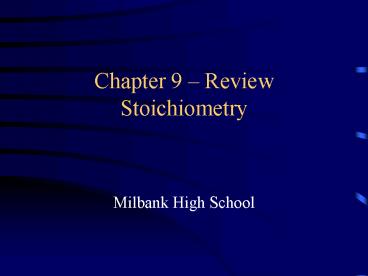Chapter 9 Review Stoichiometry - PowerPoint PPT Presentation
1 / 10
Title:
Chapter 9 Review Stoichiometry
Description:
Chapter 9 Review. Stoichiometry. Milbank High School. Chapter 9 - Review ... Limiting reagent. Theoretical yield. Stoichiometry. Percent yield. Excess reagent ... – PowerPoint PPT presentation
Number of Views:772
Avg rating:3.0/5.0
Title: Chapter 9 Review Stoichiometry
1
Chapter 9 ReviewStoichiometry
- Milbank High School
2
Chapter 9 - Review
- The calculation of quantities in chemical
equations is called ____. - What is conserved in the following reaction
H2(g) Cl2(g) ? 2HCl(g) - In every chemical reaction, what item(s) is/are
conserved?
3
Chapter 9 - Review
- What is true about the total number of reactants
and the total number of products in the given
equation C5H12(l) 8O2(g) ? 5CO2(g) 6H2O(g) - In a chemical equation, the mass of the products
is equal to _____.
4
Chapter 9 - Review
- How many moles of Al are needed to react
completely with 1.2 mol FeO?
5
Chapter 9 - Review
- What are some reasons why actual yield is less
than theoretical yield? - The reagent present in the smallest amount is ___
the limiting reagent. - For a given chemical reaction, the theoretical
yield is ____ greater than the actual yield.
6
Chapter 9 - Review
- When an equation is used to calculate the amount
of product that will form, then the value
obtained is called the _____.
7
Chapter 9 - Review
- When two substances react to form products, the
reactant which is used up is called the _____. - What mass of CaO (lime) is produced from 1.5 x
103 kg of CaCO3? CaCO3(s) ? CaO(s) CO2(g)
8
Chapter 9 - Review
- Identify the limiting reagent, and volume of CO2
formed when 11.0 L CS2 reacts with 18.0 L O2 by
CS2(g) 3 O2(g) ? CO2(g) 2SO2(g)
9
Chapter 9 - Review
- How many liters of NH3 are needed to react
completely with 30.0 L of NO (at STP)? 4 NH3(g)
6NO(g) ? 5N2(g) 6H2O(g) - The first step in most stoichiometry problems is
to _____.
10
Chapter 9 Review
- Terms
- Actual yield
- Limiting reagent
- Theoretical yield
- Stoichiometry
- Percent yield
- Excess reagent































